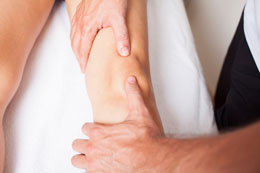When you experience a pulled quad muscle, stretching of the lower part of the legs becomes a painful experience. Read this article to know how this muscle pull occurs, its signs and symptoms and treatment options.

The 'quadriceps femoris' muscle, present in the frontal or anterior part of the thighs, stretches from the hip to the knee and is often referred to as quad muscle. This is a big and strong muscle group, which is mainly responsible for knee extension. It consists of four sets of muscles namely rectus femoris, vastus lateralis, vastus medialis and vastus intermedius. All these muscles work in coordination and enable us to straighten the lower part of the legs.
Causes
A pulled quad muscle is a condition where the muscles suffer strain and tear develops in the muscle fibers. It happens mostly while performing physically strenuous activities or playing sports like football, baseball, tennis, running, cycling, etc. The following conditions often lead to this muscular condition:
- Weakness in muscles
- Lack of flexibility
- Quad muscle not properly warmed up before strenuous activity
- Tired muscles due to overuse
- Traumatic injury to the muscles
- Stretching of the quad muscle beyond its normal range
- Lack of balance between the quad muscle and the hamstring muscle (present at the back of the thigh)
Talking about the balance between quad and hamstring muscle, both groups must work in coordination during leg movements. If both of them are not equally strong, then it creates an imbalance and the quad muscle gets pulled.
Symptoms
A pulled quad muscle is characterized by a sudden sharp pain in the upper thigh region during physical activities. It is felt on only one side of the thigh. The muscle near the upper thigh tends to stiffen up almost instantly and extending the leg becomes difficult. Running in high speed in this condition gives a popping sensation. If you touch the spot where the muscle is strained, you can feel swelling or a knot and tenderness there. Signs of bruising can be observed on the thigh skin, which is an indication that the muscle pull is severe. As a result, the muscle fibers get torn and the blood vessels in the area are ruptured. Sometimes, a gap is formed in the area because of the tear.
Treatment
Adequate amount of rest is a must to relax a pulled quad muscle. Suspend all sports activities and exercises for the time being because such activities can worsen the condition. The thigh muscles bear your entire body weight when you are on your feet. Therefore, you can use crutches to ease off the pressure from the injured muscle while moving around. An excellent treatment for the pain and swelling is ice application. Put an ice pack on the quad muscle for 15 minutes and you can feel a soothing sensation. It should be repeated 4-5 times in a day for best results. If the pain is too much, then you should take nonsteroidal anti-inflammatory medicines for the purpose of pain management. Talk to your doctor once, before taking any medicines.
During resting and icing of the pulled muscle, try to keep the affected leg at an elevated position as much as possible in order to reduce the swelling. Wrapping up the injured thigh with an ACE bandage helps a lot to control the swelling in the area. You should wear it most of the time in the first 5-7 days. Later on, as the injury heals up, continue to use it during strenuous activities. When the swelling subsides completely, heat can be used to loosen up the taut quad muscle. Once the pain and swelling is gone, light stretching exercises involving quad muscle should be introduced in the daily regime. Hold the stretch for 10 seconds but not more than that and you can repeat it 5 times a day. If the muscle has lost its strength, then physical therapy is recommended to make it stronger.
Healing time is different for every individual. It absolutely depends on the severity of the injury. A slight pull is going to heal up within a week if it is given proper rest. If it does not, then it is advisable to visit a doctor for further treatment. In serious cases, the recovery time could be several weeks or even months. In this condition, you should not jump into physical activities unless and until your doctor asks you to do so.


 The 'quadriceps femoris' muscle, present in the frontal or anterior part of the thighs, stretches from the hip to the knee and is often referred to as quad muscle. This is a big and strong muscle group, which is mainly responsible for knee extension. It consists of four sets of muscles namely rectus femoris, vastus lateralis, vastus medialis and vastus intermedius. All these muscles work in coordination and enable us to straighten the lower part of the legs.
The 'quadriceps femoris' muscle, present in the frontal or anterior part of the thighs, stretches from the hip to the knee and is often referred to as quad muscle. This is a big and strong muscle group, which is mainly responsible for knee extension. It consists of four sets of muscles namely rectus femoris, vastus lateralis, vastus medialis and vastus intermedius. All these muscles work in coordination and enable us to straighten the lower part of the legs.